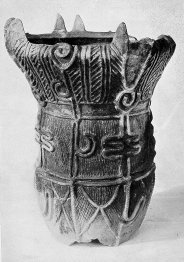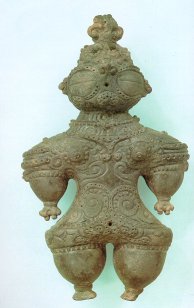
Jomon Period 10,000 BCE-300BCE

A figurine from the late Jomon period
The earliest settlers who came to Japan are referred to as the Jomon people. The name "Jomon" comes from the type of cord-impressed pottery that this early people produced. They might have been related to the Ainu and were of Caucasian stock. They may have come originally from northern India, migrating to central Asia, Manchuria, and Siberia and finally ended up in Japan.

A clay pot from this time period
The pottery vessels made during this time are the earliest art objects made in Japan. The vessels are called doki (rope-design ware), and the idols that were made are called dogu, or clay dolls. The heavy pots used coils of clay and highly varied decorative designs which many consider to be the best made of any Stone Age culture. Both the pottery and the figures show considerable workmanship and expression.

A clay figure from this period. This is the type of work that I've seen elsewhere used as "proof" that earlier civilizations were exposed to spacemen. In some ways the figure does resemble a being in a spacesuit, though. You can see the great detail and workmanship in this piece. The clay figurines were of humans and animals. Since most of the ones that have been found were in domestic sites it's assumed that they were idols used for worship and not burial items. As for the human figures, most of them are female with large breasts and hips, a trait also seen in early European figurines.
Since there is almost nothing textile-wise remaining from that times people speculate about what these earliest people wore. It's thought that they wore loose fitting trousers that were tied at the waste along with upper garments with sleeves. These were probably of the pullover type with V-necks. They also had robes made from the bark of mulberry trees.
Their diet consisted of bear, boar, deer, fish, shell-fish, yams, wild grapes, walnuts, chestnuts and acorns.
It is also probable that the Japanese language had its origins during this period.
By the end of the Jomon period the population of the area is estimated to have been around 100,000 people.
Note: there is also a listing which breaks the Jomon period down into various sub-sections which include Incipient Jomon (13,000-8000 B.C.E); Earliest Jomon (8000-5000 B.C.E.); Early Jomon (5000-2500 B.C.E.); Middle Jomon (2500-1500 B.C.E.); Late Jomon (1500-1000 B.C.E.), and Final Jomon (1000-300 B.C.E.)
Specific dates of importance
660 BCE: The first Japanese Emperor, Jimmu, regarded as a descendant of the sun-goddess Amaterasu, begins his rule according to legend. Jimmu is said to have ruled until the year 585BCE. Jimmu's first title was Mikoto (lord, prince), and his rule was over the family clan and other great clans. One of his titles was "Supreme Majest who laid the foundations of the Empire."
Note: dates are not necessarily historically accurate. Many are taken from a book written in the year 720 C.E.so some, if not all, would have some variance from the "real" dates of their reigns.
660-585 B.C.E.:Emperor Jimmu
581-549 B.C.E.: Emperor Suizei
549-511 B.C.E. Emperor Annei
510-477 B.C.E.: Emperor Itoku
475-393 B.C.E.: Emperor Kosho
392-291 B.C.E.: Emperor Koan
Main Index
Japan main page
Japanese-American Internment Camps index page
Japan and World War II index page
Back to start of Japanese history section
|